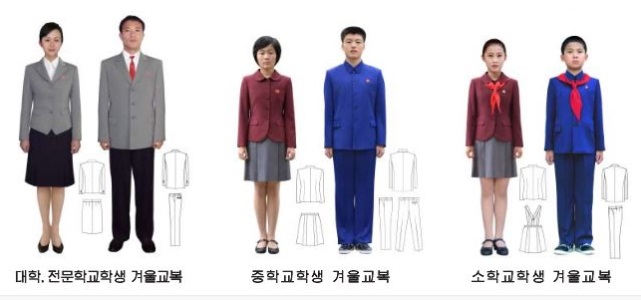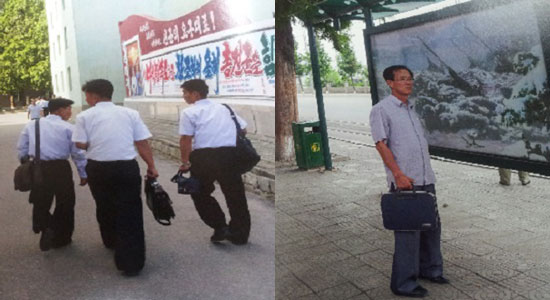Last month, North Korea’s state-run weekly, Tongil Sinbo, unveiled new school uniforms featuring dramatic changes in color and design. Media within the North reported that leader Kim Jong Eun
underscored the importance of uniform production, propagating Kim’s love for the
younger generation and thereby trying to rally up their loyalty.
School uniforms were once distributed for
free in the North, starting in 1959. In 1977, to celebrate then-leader Kim Il Sung’s
65th birthday, the state distributed a uniform gift package for students– from
kindergarten all the way up to university–comprising summer and winter uniforms,
shoes, bags, and scarves. This trend of “crowd-pleasing uniform politics”
was carried out once in two to three years up until the late 1980s. However, as
the country entered the Arduous March [North Korea’s famine of the mid-1990s]free distribution was brought
to a halt.
In 2007, marking Kim Jong Il’s 65th
birthday, the state started distributing uniforms every three years until April
2012 for 5,000 KPW [0.63 USD]. However, as the quality of the fabric rendered the entire uniform substandard, students started turning to market-produced outfits
with designs emulating that of the state-dispensed ones. More than 70 percent of the student
population currently don these unofficial uniforms, making it impossible for the
schools to effectively regulate due to the sheer number of pupils.
In contrast to the navy blue state-issued garb, the popular market-manufactured uniforms are made with black fabric, earning them the name “black ink uniforms” at the markets. Female students also outfit their uniforms with sailor collars; they also lean toward brighter colors for their casual wear because of their exposure to trends in the South.
Daily NK recently sat down with a student, who escaped
the North in October after attending high school in Nampo, to learn more about changing
uniform trends, how schools react to them, and what to make of the new uniforms the state rolled out.
 The new uniforms for university (left), middle school (center), and elementary school (right) released by the the Tongil Sinbo last month. Image: Tongil Sinbo |
Daily NK [DNK]: North Korea unveiled its
new uniform. How do you think students will react?
The colors are brighter, but any student
who sees this is going to think it’s unfashionable. The original uniform comes
in dark navy blue, but as that color gets lighter it looks increasingly old-fashioned so
the male students won’t like it. Students these days, girls or boys, all like
to get their uniforms made with black fabric. So if you’re making the uniforms
brighter than they already were none of them are going to want to wear it–especially the boys.
Another thing is that pant legs’ trends for guys are not nearly this wide. The newly issued pants have wide legs, but when students normally
reach the third grade in middle school, they start drawing them in to look more
stylish. If they have to wear these new uniforms they will probably get them
tailored for a slimmer fit. As for the girls’ uniform, it resembles what
many women wear after they graduate from school, so I think the response will
be okay.
DNK: Why do students love black so much?
What colors do they prefer to wear?
Both male and female students all want
black when they go to the markets to buy their uniforms. I think the “blank ink uniforms” became so popular because they look so similar to attire commonly worn by high-level officials. Those uniforms sell really well at the markets.
Female students though also like somewhat
lighter colors such as green, gray, beige, and navy, since they’re not too dark
but more fashionable. Most of the clothes from Japan or South Korea come in
these colors. The new uniform for girls looks like it’s in that range but not
quite. The gray is good, but the maroon is not a popular color with them–it’s definitely going to take them some time to get used to it, if ever.
DNK: Don’t you get in trouble if you don’t
wear the state-sanctioned uniforms?
Everyone has to buy the uniforms whether
they like it or not, but the schools can’t force you to wear them. Wearing them
strips you of all your confidence, seriously. Even the children of teachers go
to the market to buy their uniforms. If you wear the state uniforms you end up feeling like an outcast and losing your self-assurance, which ends up affecting your performance in the classroom.
Not even 30 percent of the students wear
the state uniforms. Other than those who come from the very poorest households,
everyone else buys them at the market. Some students even get measured at the
markets to have their uniforms custom made with high-quality fabric. By the end of March,
there will probably be uniforms in the markets designed to look similar to the
new ones. These will fetch around 150,000 [18.75 USD] to 200,000 KPW [25 USD], whereas the state
ones only cost 5,000 KPW [0.63 USD].
DNK: What other attire do students wear
aside from their uniforms?
Both boys and girls like to wear sporty
clothing, particularly the hoodies favored by South Korean students. Boys
like jeans [only black–blue jeans are too conspicuous] as well, but that’s monitored closely by teachers overseeing student
groups. If you’re caught wearing jeans, the teacher will come up to you and cut
them with a utility knife right down the center.
Girls like to wear form-fitting clothing,
but they’re not allowed to wear high heels even though they’d like to. Valenki boots, which are super popular in the winter, are strictly forbidden, so they usually just wear flats or sneakers instead.
DNK: Tell us about their hairstyles.
They’re very strict with hair lengths and styles for boys; if you don’t have
it cut close in the back or if the hair in the front grows out a bit, they’ll
give you a stern warning. If you fail to take care of it even after the initial notification, the teacher overseeing your student group will use a hair clipper and shave it right
down the middle of your head. Then you have to go get your entire head shaved
at the barber shop and wear a hat until it grows out again.
Girls have more freedom with their hair.
They can let it grow out but they’re told to braid it. Boys usually make fun
of them if they do, calling it old-fashioned, so girls like to grow it out
right above the length required for braiding. If you have long hair you’re allowed to use a small
hair tie, but anything flashy like a ribbon or large bows are strictly forbidden. The bob cut so prevalent in the South is the most chic style. Those in the North with shorter hair generally perm it straight or do things to add a little volume to it.
DNK: Does the state give you bags, shoes,
and stationary at the beginning of the school year?
They only give you a uniform and textbooks.
Until 2013 they used to distribute second-hand textbooks, but from 2014–when
they started the new 12th grade mandatory education system–they’ve been
handing out new books. Anything else like shoes, bags, and stationary, you have
to buy at the markets.
Boys usually wear sneakers, and girls wear
flats made from fabric. The best sneakers are the ones produced at a factory in Sinuiju that go for about 25,000 KPW [3.13 USD]. By contrast, those manufactured by cottage industries cost roughly 12,000 KPW [1.5 USD]. The closer you get to the Hamkyung Provinces the more expensive the prices get.
Elementary school students commonly use
backpacks, while middle and high school students opt for handheld bags or
messenger bags. The most popular bag these days is the one that looks like a laptop
bag. It’s called the “Minamja” bag because that’s what it says on the tag at
the market. It’s actually a Chinese brand but a lot of students are under the impression that it’s from the South. The prices range from 7 to 30 USD.





















